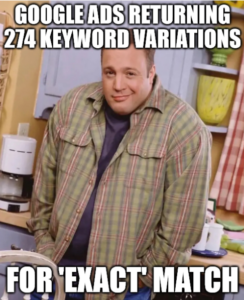Let me tell you about a scary story that happened recently to a friend.
She was alone, working remotely on her three monitors. Outside her window, the wind howled as it whipped through the trees, slowing down her internet service. She checked on her most recent SEM campaign, excited to see the results of her perfectly planned keywords and ads. The client had a beautiful website that the ads linked to, with relevant content and a great page experience for visitors. Nothing could go wrong.
As she navigated to the campaign, she frowned.
“These CPCs can’t be right!” She thought. “And what are these trash CTRs?”
Frantically checking everything she set up, she could find no fault. The campaign was planned based on historical data. What could have possibly gone wrong?
Finally, she opened the search terms report to tell her what phrases people searched to trigger an ad. Chills ran up her spine and she let out a soft groan as the screen slowly loaded before her. Most of the phrases that Google allowed an ad to show for were only faintly relevant to the curated keywords she expertly used.
“What is happening?” She wailed. “Why are you doing this to me, Google?”
***
Well, what happened was Google has continued to relax their rules on keyword match types. And that friend who experienced this frightening revelation was me. Not just me, though. SEM planners from all over are struggling to keep their campaigns in control.
Over time, Google has switched how match types work. Before, keywords searched matched closely to the keyword being used in a campaign, depending on what match type was used. There are three types available and this is how they used to work:
- Broad: Essentially showed for anything remotely similar to your keyword. For example, if you used the keyword lawn mowing service, an ad could show if someone typed landscapers near me or mowers on sale.
- Phrase: Would show for any keyword that used words before or after your phrase matched keyword. For example, if your keyword was “lawn mowing service”, ads could show for a person searching lawn mowing service Vancouver.
- Exact: This was the strictest of match types, only showing for ads that matched your keyword. The keyword [lawn mowing service] would only show for people searching that query. It did allow for misspellings and pluralization.
It was this way for a very long time. A couple of years ago, Google switched it slightly, so that it still utilized those match types, but now it could look at the intent of a person’s search. Phrase matched keywords could now show if someone searched something similar, such as “services for grass cutting”. Still pretty close, but advertisers had to become more diligent with adding in negative keywords and smarter about the keywords chosen.
The past few months, Google has loosened it again, so that ads can show for any searched query that includes the meaning of a campaign’s keyword. The meaning is decided by Google and is very open to interpretation.
Phrase matched keywords have become the old version of broad. Even exact matched keywords are no longer as safe. In one campaign, the keyword returning the most clicks was exact matched. I ran the search terms report for it, and it returned 274 variations. Previously it would have returned about three at the most. To be fair, the majority of the variations were relevant, but I still had to review the report and add in a few negative keywords, to ensure the exact matched keyword was performing as it was supposed to. Thank you to Gillian for this perfect meme.

So what does this mean? It means the keywords need to be monitored extensively. They need to be refined more often than before. Negative keywords need to be added in regularly. It means advertisers have less and less control, and it will get worse. The inclusion of AI to more platforms means that it’s predicted Google will take away match types completely. If this happens, campaign reporting will likely become less transparent. Google will spit out an overall scoring of a campaign, urging advertisers to increase budgets to reach more people. Very similar to how Google’s Performance Max campaigns operate now (spoiler: not great).
These changes may also coincide with the reported decrease in click volume.
Until that happens, I’ve been focusing on a 70% exact match/30% phrase match split for ongoing campaigns, and 50% exact/50% phrase split for new campaigns. If there’s historical data, it’s easier to get an idea of which keywords should be exact matched. If it’s a new campaign however, in a vertical you don’t have much research on, then start with 50/50 and slowly increase the exact matching as the campaign progresses.
You may ask, why not just do all exact matched keywords? If you limit yourself to only exact matched, you won’t get a clear picture of any trends or changes to the search behaviour. Leaving some long-tailed keywords as phrase will help identify those trends in the search terms report. Just be sure to check often, and add in negative terms as you go.
For now, it’s time to tighten up…while we still can.
